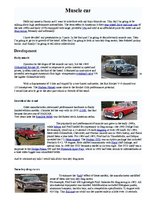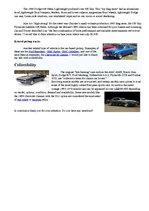Muscle car is a term used to refer to a variety of high performance automobiles. The term refers to American 2-door rear wheel drive mid-size cars of the late 1960s and early 1970s equipped with large, powerful V8s and sold at an affordable price for street use and drag racing, formally and informally.
Development
Early muscle
Opinions on the origin of the muscle car vary, but the 1949 Oldsmobile Rocket 88, created in response to public interest in speed and power, is often cited as the first of the breed.
Growth of the trend
Manufacturers showcased performance hardware in flashy limited-edition models. Chrysler led the way with its 1955 C-300, that fast became the new star of NASCAR.
Two years later the Rambler Rebel was the fastest stock American sedan.
The popularity and performance of muscle cars grew in the early 1960s, while Mopar and Ford battled for supremacy in drag racing.
Turn-key drag racers
All non-essential equipment was omitted. Modifications included fiberglass panels, aluminum bumpers, traction bars, and a competition specification 7L engine with 425 bhp.
Like other lightweights of the era it came with a factory disclaimer: Designed for supervised acceleration trials. …




























